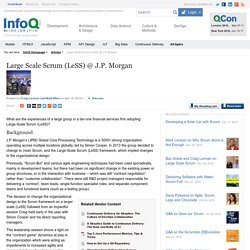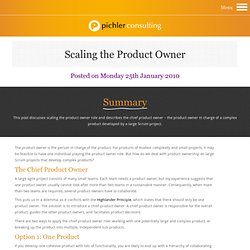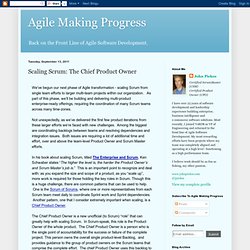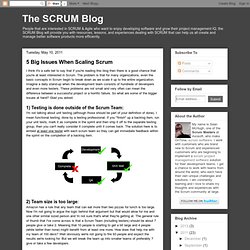

Escalando Scrum - Primera parte. Large Scale Scrum - More with LeSS. Background In 2003, when Craig published Agile & Iterative Development [1], many “knew” that agile development was for small groups.

However, we became interested in – and got increasing requests – to apply Scrum to very large, multisite, and offshore product development. So, since 2005 we have worked with clients to scale up – often for “embedded” systems. Today, the two Large-Scale Scrum (LeSS) frameworks described herein have been introduced to big groups worldwide in disparate domains, including telecom-infrastructure-equipment providers such as Ericsson [2], investment-banking clients such as Bank of America-Merrill Lynch and JPMorgan, plus many more.
To quantify “large”, we’ve seen our LeSS framework–2 applied in groups of up to 1500 people, involving 7 developments sites spanning the globe. Large Scale Scrum (LeSS) @ J.P. Morgan. What are the experiences of a large group in a tier-one financial services firm adopting Large-Scale Scrum (LeSS)?

Background J.P. Morgan’s (JPM) Global Core Processing Technology is a 3000+ strong organization operating across multiple locations globally, led by Simon Cooper. In 2013 the group decided to change to (real) Scrum, and the Large-Scale Scrum (LeSS) framework, which implied changes to the organizational design. Previously, “Scrum-But” and various agile engineering techniques had been used sporadically, mainly in development teams, but there had been no significant change in the existing power or group structures, or in the interaction with business -- which was still “contract negotiation” rather than “customer collaboration”. The decision to change the organizational design to the Scrum framework on a larger scale (LeSS) followed from an impactful session Craig held early in the year with Simon Cooper and his direct reporting managers. 201305-larman. Beyond Scrum: Methods for Supporting Distributed Teams. This is the second in a four-part series on Scrum.

Scrum is the most popular Agile techniques, but it doesn’t scale well. And while Scrum improves the effectiveness of individual teams, productivity gains fall off sharply on large projects with many teams. In our first article on this topic, we discussed how to apply agile techniques to distributed teams and large projects. In this month’s Head Revision, we’ll turn to tools and techniques for managing distributed teams.
Figure 1: A Scalable Agile process framework (Source: Assembla, Inc.) Let’s look at some of the processes and tools needed to manage the Scalable Agile process framework shown above (see Figure 1). The first of these “building blocks” is support for distributed teams. So how can organizations support distributed teams well enough to reduce the need for face-to-face meetings? Online Agile Planning Online tools can replace paper-and-pencil planning exercises and physical whiteboards. Online Collaboration Global Code Management. Www.controlchaos.com/storage/scrum-articles/Sutherland 200111 proof.pdf.
How to Scale the Scrum Product Owner. The product owner is the person in charge of the product.

For products of modest complexity and small projects, it may be feasible to have one individual playing the product owner role. But how do we deal with product ownership on large Scrum projects that develop complex products? The Chief Product Owner A large agile project consists of many small teams. Each team needs a product owner, but my experience suggests that one product owner usually cannot look after more than two teams in a sustainable manner. This puts us in a dilemma, as it conflicts with the Highlander Principle, which states that there should only be one product owner. There are two ways to apply the chief product owner role: working with one potentially large and complex product, or breaking up the product into multiple, independent sub products. Agile Making Progress: Scaling Scrum: The Chief Product Owner. We’ve begun our next phase of Agile transformation - scaling Scrum from single team efforts to larger multi-team projects within our organization.

As part of this phase, we’ll be building and delivering multi-product enterprise-ready offerings, requiring the coordination of many Scrum teams across many time-zones. Not unexpectedly, as we’ve delivered the first few product iterations from these larger efforts we’re faced with new challenges. Among the biggest are coordinating backlogs between teams and resolving dependencies and integration issues. Both issues are requiring a lot of additional time and effort, over and above the team-level Product Owner and Scrum Master efforts.
In his book about scaling Scrum, titled The Enterprise and Scrum, Ken Schwaber states “The higher the level is, the harder the Product Owner’s and Scrum Master’s job is.” It is important to note that this role is filled by an individual, not a committee. The SCRUM Blog: 5 Big Issues When Scaling Scrum. I think it's a safe bet to say that if you're reading this blog then there is a good chance that you're at least interested in Scrum.

The problem is that for many organizations, even the basic concepts in Scrum begin to break down as we scale it up to the entire organization. Imagine a daily stand-up when the development team consists of hundreds of developers and even more testers. These problems are not small and very often can mean the difference between a successful project or a horrific failure. So what are some of the bigger issues at hand? Glad you asked. Scalability - Scaling Scrum within a group of 100s of programmers. Scrum de Scrum: Tamaño del equipo, frecuencia y más. Scrum Team Training. Scrum of Scrum: Team Size, Frequency and More.